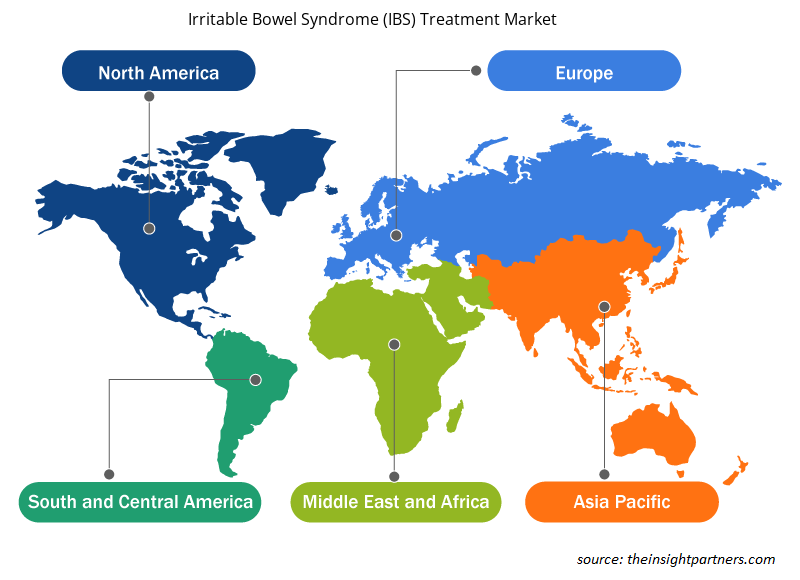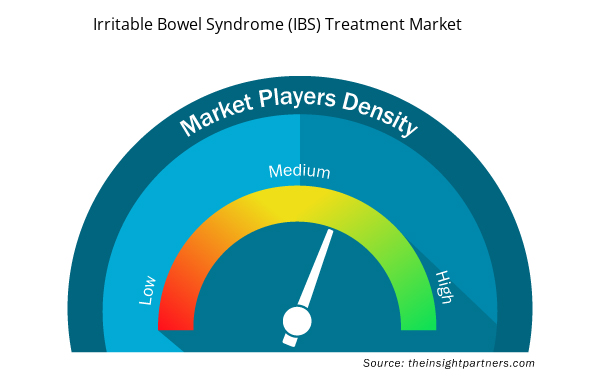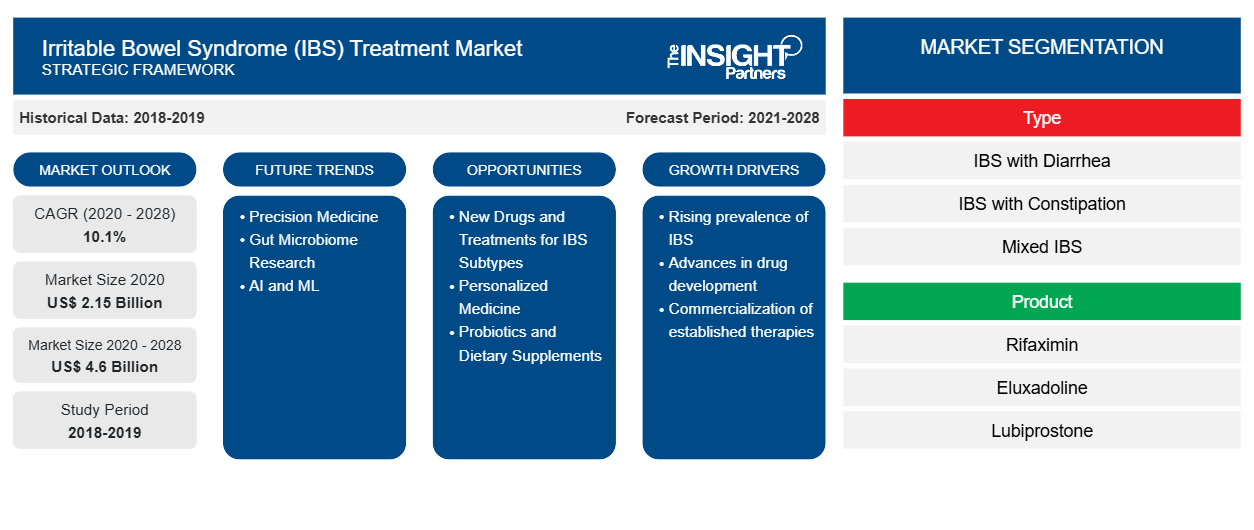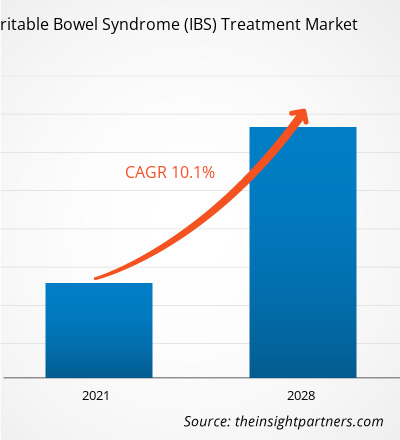Il mercato dei trattamenti per la sindrome dell'intestino irritabile (IBS) è stato valutato 2.153,89 milioni di dollari nel 2020 e si prevede che raggiungerà i 4.600,30 milioni di dollari entro il 2028; si prevede una crescita a un CAGR del 10,1% dal 2021 al 2028.
I principali fattori, come la crescente prevalenza di malattie della sindrome dell'intestino irritabile e le crescenti attività di ricerca e sviluppo, guidano la crescita del mercato. Tuttavia, la limitata disponibilità di prodotti e l'inefficienza del trattamento frenano la crescita del mercato. L'IBS è una comune condizione cronica che colpisce l'organo addominale, l'intestino crasso. È anche nota come colon spastico, colite mucosa, colon irritabile e colite spastica. La condizione è molto diversa dalla malattia infiammatoria intestinale. Presenta sintomi come crampi, dolore addominale, gonfiore, gas e diarrea o costipazione, o entrambi contemporaneamente. Se i sintomi sono lievi, possono essere gestiti cambiando stress, stile di vita e dieta. D'altro canto, i sintomi gravi vengono trattati con farmaci e consulenza.
Nella regione APAC sono state implementate numerose misure per contenere la diffusione del nuovo coronavirus che causa il COVID-19. Tali misure hanno interrotto le operazioni di molte aziende in vari settori, tra cui quello sanitario. La quarantena del personale, i fallimenti della supply chain e le riduzioni della domanda hanno generato gravi complicazioni per le aziende. Inoltre, si è verificato un calo significativo delle cure ospedaliere e ambulatoriali nelle catene di ospedali privati. Per alleviare i sistemi sanitari, molte cliniche stanno posticipando gli appuntamenti non critici. Questo scenario sta ostacolando la crescita del trattamento della sindrome dell'intestino irritabile (IBS).
Personalizza questo report in base alle tue esigenze
Riceverai la personalizzazione gratuita di qualsiasi report, comprese parti di questo report, o analisi a livello nazionale, pacchetto dati Excel, oltre a usufruire di grandi offerte e sconti per start-up e università
- Scopri le principali tendenze di mercato in questo rapporto.Questo campione GRATUITO includerà analisi di dati che spaziano dalle tendenze di mercato alle stime e alle previsioni.
Approfondimenti di mercato
Aumento della prevalenza della sindrome dell'intestino irritabile e delle condizioni associate
La sindrome dell'intestino irritabile è una condizione gastrointestinale cronica ampiamente osservata, causata da disturbi nelle abitudini intestinali e dolore addominale. La malattia è anche nota come colon spastico, colon irritabile, colite mucosa e colite spastica. La sindrome dell'intestino irritabile presenta sintomi quali dolore addominale, stitichezza, diarrea e crampi. I sistemi sanitari di tutte le regioni stanno assistendo a una crescita considerevole nell'incidenza della sindrome dell'intestino irritabile. Un dato pubblicato dall'International Foundation for Gastrointestinal Disorders afferma che tra tutti i pazienti con IBS, circa il 40% dei pazienti ha una IBS lieve, circa il 35% ha una IBS moderata e circa il 25% soffre di IBS grave. Molte persone non riconoscono i sintomi della IBS.
Alcuni fattori come allergie alimentari, stadi di sviluppo di gastroenterite, movimenti sporadici del colon, composizione anomala della serotonina nel colon e celiachia lieve sono tra i fattori di rischio che possono causare la sindrome dell'intestino irritabile. Si prevede che questi fattori accelerino il tasso di prevalenza della sindrome dell'intestino irritabile in tutto il mondo. Ad esempio, secondo uno studio pubblicato su NCBI nel 2018, si stima che la sindrome dell'intestino irritabile colpisca circa il 10%-16% della popolazione statunitense ogni anno. È probabile che una prevalenza così sbalorditiva della sindrome dell'intestino irritabile (IBS) aumenti il mercato dei trattamenti per la sindrome dell'intestino irritabile (IBS) durante il periodo di previsione.
Informazioni basate sul tipo
In base al tipo, il mercato del trattamento della sindrome dell'intestino irritabile (IBS) è segmentato in IBS mista (IBS-M), IBS con diarrea (IBS-D) e IBS con stitichezza (IBS-C). Nel 2020, il segmento IBS mista (IBS-M) ha detenuto la quota maggiore del mercato. Inoltre, si prevede che lo stesso segmento registrerà il CAGR più elevato durante il periodo di previsione. Si prevede che la crescente prevalenza di IBS tra donne e uomini spingerà la domanda di medicinali in grado di trattare i sintomi combinati di stitichezza e diarrea. La prevalenza di IBS è più elevata nella popolazione anziana. Pertanto, è probabile che la domanda di medicinali per il trattamento di IBS mista cresca in modo significativo durante il periodo di previsione,
Approfondimenti basati sui prodotti
In base al prodotto, il mercato del trattamento della sindrome dell'intestino irritabile (IBS) è segmentato in rifaximina, eluxadolina, lubiprostone, linaclotide e altri. Il segmento linaclotide ha detenuto la quota maggiore del mercato nel 2020. Inoltre, si stima che lo stesso segmento registrerà il CAGR più elevato nel mercato durante il periodo di previsione. La crescita del mercato per il segmento è attribuita a fattori quali la crescente produzione di una versione generica di linaclotide e il crescente consolidamento del mercato per lo sviluppo e la commercializzazione di linaclotide per il trattamento dell'IBS.
Informazioni basate sui canali di distribuzione
In base al canale di distribuzione, il mercato del trattamento della sindrome dell'intestino irritabile (IBS) è segmentato in farmacie ospedaliere, farmacie e farmacie al dettaglio e farmacie online. Nel 2020, il segmento delle farmacie ospedaliere ha detenuto la quota maggiore del mercato. Tuttavia, si prevede che il segmento delle farmacie e delle farmacie al dettaglio registrerà il CAGR più elevato durante il periodo di previsione.
Le aziende che operano nel mercato del trattamento della sindrome dell'intestino irritabile (IBS) adottano la strategia di innovazione dei prodotti per soddisfare le mutevoli esigenze dei clienti in tutto il mondo, il che consente loro anche di mantenere il proprio marchio sul mercato globale.
Ambito del rapporto di mercato sul trattamento della sindrome dell'intestino irritabile
Sindrome dell'intestino irritabile (IBS) Trattamento Mercato Regionale Insights
Le tendenze regionali e i fattori che influenzano il mercato del trattamento della sindrome dell'intestino irritabile (IBS) durante il periodo di previsione sono stati ampiamente spiegati dagli analisti di Insight Partners. Questa sezione discute anche i segmenti del mercato del trattamento della sindrome dell'intestino irritabile (IBS) e la geografia in Nord America, Europa, Asia Pacifico, Medio Oriente e Africa e Sud e Centro America.

- Ottieni i dati specifici regionali per il mercato del trattamento della sindrome dell'intestino irritabile (IBS)
Ambito del rapporto di mercato sul trattamento della sindrome dell'intestino irritabile (IBS)
| Attributo del report | Dettagli |
|---|---|
| Dimensioni del mercato nel 2020 | 2,15 miliardi di dollari USA |
| Dimensioni del mercato entro il 2028 | 4,6 miliardi di dollari USA |
| CAGR globale (2020 - 2028) | 10,1% |
| Dati storici | 2018-2019 |
| Periodo di previsione | 2021-2028 |
| Segmenti coperti | Per tipo
|
| Regioni e Paesi coperti | America del Nord
|
| Leader di mercato e profili aziendali chiave |
|
Densità degli attori del mercato: comprendere il suo impatto sulle dinamiche aziendali
Il mercato del trattamento della sindrome dell'intestino irritabile (IBS) sta crescendo rapidamente, spinto dalla crescente domanda degli utenti finali dovuta a fattori quali l'evoluzione delle preferenze dei consumatori, i progressi tecnologici e una maggiore consapevolezza dei benefici del prodotto. Con l'aumento della domanda, le aziende stanno ampliando la propria offerta, innovando per soddisfare le esigenze dei consumatori e capitalizzando sulle tendenze emergenti, il che alimenta ulteriormente la crescita del mercato.
La densità degli operatori di mercato si riferisce alla distribuzione di aziende o società che operano in un particolare mercato o settore. Indica quanti concorrenti (operatori di mercato) sono presenti in un dato spazio di mercato in relazione alle sue dimensioni o al valore di mercato totale.
Le principali aziende che operano nel mercato del trattamento della sindrome dell'intestino irritabile (IBS) sono:
- Azienda farmaceutica Ironwood, Inc.
- AbbVie.
- Azienda farmaceutica Sebela, Inc.
- Takeda Pharmaceutical Company Limited
- Alfasigma SpA
Disclaimer : le aziende elencate sopra non sono classificate secondo un ordine particolare.

- Ottieni la panoramica dei principali attori del mercato dei trattamenti per la sindrome dell'intestino irritabile (IBS)
Mercato del trattamento della sindrome dell'intestino irritabile (IBS) - per tipo
- IBS con diarrea (IBS-D)
- IBS con stitichezza (IBS-C)
- Sindrome dell'intestino irritabile mista (IBS-M)
Mercato dei trattamenti per la sindrome dell'intestino irritabile (IBS) - per prodotto
- Rifaximina
- Eluxadolina
- Linaclotide
- Lubiprostone
- Altri
Mercato del trattamento della sindrome dell'intestino irritabile (IBS) - per canale di distribuzione
- Ospedali Farmacie
- Farmacie e farmacie al dettaglio
- Farmacie online
Mercato del trattamento della sindrome dell'intestino irritabile (IBS) - per area geografica
America del Nord
- NOI
- Canada
- Messico
Europa
- Francia
- Germania
- Italia
- Regno Unito
- Spagna
- Resto d'Europa
Asia Pacifico (APAC)
- Cina
- India
- Corea del Sud
- Giappone
- Australia
- Resto dell'APAC
Medio Oriente e Africa (MEA)
- Sudafrica
- Arabia Saudita
- Emirati Arabi Uniti
- Resto del MEA
America del Sud e Centro (SCAM)
- Brasile
- Argentina
- Resto della TRUFFA
Profili aziendali
- Azienda farmaceutica Ironwood, Inc.
- AbbVie.
- Azienda farmaceutica Sebela, Inc.
- Takeda Pharmaceutical Company Limited
- Alfasigma SpA
- Astellas Pharma Inc.
- AstraZeneca
- Società biologica sintetica, Inc.
- Bausch + Lomb Incorporated
- Lannett Company Inc
- Analisi storica (2 anni), anno base, previsione (7 anni) con CAGR
- Analisi PEST e SWOT
- Valore/volume delle dimensioni del mercato - Globale, regionale, nazionale
- Industria e panorama competitivo
- Set di dati Excel



Report Coverage
Revenue forecast, Company Analysis, Industry landscape, Growth factors, and Trends

Segment Covered
This text is related
to segments covered.

Regional Scope
North America, Europe, Asia Pacific, Middle East & Africa, South & Central America

Country Scope
This text is related
to country scope.
Domande frequenti
The irritable bowel syndrome (IBS) treatment market majorly consists of the players such as Ironwood Pharmaceuticals, Inc., AbbVie., Sebela Pharmaceuticals, Inc., Takeda Pharmaceutical Company Limited, Alfasigma S.p.A., Astellas Pharma Inc., AstraZeneca, Synthetic Biologics, Inc., Bausch + Lomb Incorporated and Lannett Company Inc amongst others.
The factors that are driving growth of the market are increasing prevalence of irritable bowel syndrome diseases and increasing research & development activities.
Irritable bowel syndrome (IBS) is a common disorder that affects the abdominal organ, large intestine. It is also known as spastic colon, mucous colitis, irritable colon, and spastic colitis. The condition is much different than inflammatory bowel disease. However, it is a chronic condition which a person must manage for a longer period. It shows symptoms such as cramping, abdominal pain, bloating, gas, and diarrhea or constipation, or both at the same. These symptoms can be managed by changing stress, lifestyle, and diet. And the more severe symptoms are treated with medication and counseling.
Trends and growth analysis reports related to Life Sciences : READ MORE..
The List of Companies - Irritable Bowel Syndrome (IBS) Treatment Market
- Ironwood Pharmaceuticals, Inc.
- AbbVie.
- Sebela Pharmaceuticals, Inc.
- Takeda Pharmaceutical Company Limited
- Alfasigma S.p.A.
- Astellas Pharma Inc.
- AstraZeneca
- Synthetic Biologics, Inc.
- Bausch + Lomb Incorporated
- Lannett Company Inc
The Insight Partners performs research in 4 major stages: Data Collection & Secondary Research, Primary Research, Data Analysis and Data Triangulation & Final Review.
- Data Collection and Secondary Research:
As a market research and consulting firm operating from a decade, we have published and advised several client across the globe. First step for any study will start with an assessment of currently available data and insights from existing reports. Further, historical and current market information is collected from Investor Presentations, Annual Reports, SEC Filings, etc., and other information related to company’s performance and market positioning are gathered from Paid Databases (Factiva, Hoovers, and Reuters) and various other publications available in public domain.
Several associations trade associates, technical forums, institutes, societies and organization are accessed to gain technical as well as market related insights through their publications such as research papers, blogs and press releases related to the studies are referred to get cues about the market. Further, white papers, journals, magazines, and other news articles published in last 3 years are scrutinized and analyzed to understand the current market trends.
- Primary Research:
The primarily interview analysis comprise of data obtained from industry participants interview and answers to survey questions gathered by in-house primary team.
For primary research, interviews are conducted with industry experts/CEOs/Marketing Managers/VPs/Subject Matter Experts from both demand and supply side to get a 360-degree view of the market. The primary team conducts several interviews based on the complexity of the markets to understand the various market trends and dynamics which makes research more credible and precise.
A typical research interview fulfils the following functions:
- Provides first-hand information on the market size, market trends, growth trends, competitive landscape, and outlook
- Validates and strengthens in-house secondary research findings
- Develops the analysis team’s expertise and market understanding
Primary research involves email interactions and telephone interviews for each market, category, segment, and sub-segment across geographies. The participants who typically take part in such a process include, but are not limited to:
- Industry participants: VPs, business development managers, market intelligence managers and national sales managers
- Outside experts: Valuation experts, research analysts and key opinion leaders specializing in the electronics and semiconductor industry.
Below is the breakup of our primary respondents by company, designation, and region:

Once we receive the confirmation from primary research sources or primary respondents, we finalize the base year market estimation and forecast the data as per the macroeconomic and microeconomic factors assessed during data collection.
- Data Analysis:
Once data is validated through both secondary as well as primary respondents, we finalize the market estimations by hypothesis formulation and factor analysis at regional and country level.
- Macro-Economic Factor Analysis:
We analyse macroeconomic indicators such the gross domestic product (GDP), increase in the demand for goods and services across industries, technological advancement, regional economic growth, governmental policies, the influence of COVID-19, PEST analysis, and other aspects. This analysis aids in setting benchmarks for various nations/regions and approximating market splits. Additionally, the general trend of the aforementioned components aid in determining the market's development possibilities.
- Country Level Data:
Various factors that are especially aligned to the country are taken into account to determine the market size for a certain area and country, including the presence of vendors, such as headquarters and offices, the country's GDP, demand patterns, and industry growth. To comprehend the market dynamics for the nation, a number of growth variables, inhibitors, application areas, and current market trends are researched. The aforementioned elements aid in determining the country's overall market's growth potential.
- Company Profile:
The “Table of Contents” is formulated by listing and analyzing more than 25 - 30 companies operating in the market ecosystem across geographies. However, we profile only 10 companies as a standard practice in our syndicate reports. These 10 companies comprise leading, emerging, and regional players. Nonetheless, our analysis is not restricted to the 10 listed companies, we also analyze other companies present in the market to develop a holistic view and understand the prevailing trends. The “Company Profiles” section in the report covers key facts, business description, products & services, financial information, SWOT analysis, and key developments. The financial information presented is extracted from the annual reports and official documents of the publicly listed companies. Upon collecting the information for the sections of respective companies, we verify them via various primary sources and then compile the data in respective company profiles. The company level information helps us in deriving the base number as well as in forecasting the market size.
- Developing Base Number:
Aggregation of sales statistics (2020-2022) and macro-economic factor, and other secondary and primary research insights are utilized to arrive at base number and related market shares for 2022. The data gaps are identified in this step and relevant market data is analyzed, collected from paid primary interviews or databases. On finalizing the base year market size, forecasts are developed on the basis of macro-economic, industry and market growth factors and company level analysis.
- Data Triangulation and Final Review:
The market findings and base year market size calculations are validated from supply as well as demand side. Demand side validations are based on macro-economic factor analysis and benchmarks for respective regions and countries. In case of supply side validations, revenues of major companies are estimated (in case not available) based on industry benchmark, approximate number of employees, product portfolio, and primary interviews revenues are gathered. Further revenue from target product/service segment is assessed to avoid overshooting of market statistics. In case of heavy deviations between supply and demand side values, all thes steps are repeated to achieve synchronization.
We follow an iterative model, wherein we share our research findings with Subject Matter Experts (SME’s) and Key Opinion Leaders (KOLs) until consensus view of the market is not formulated – this model negates any drastic deviation in the opinions of experts. Only validated and universally acceptable research findings are quoted in our reports.
We have important check points that we use to validate our research findings – which we call – data triangulation, where we validate the information, we generate from secondary sources with primary interviews and then we re-validate with our internal data bases and Subject matter experts. This comprehensive model enables us to deliver high quality, reliable data in shortest possible time.


 Ottieni un campione gratuito per questo repot
Ottieni un campione gratuito per questo repot